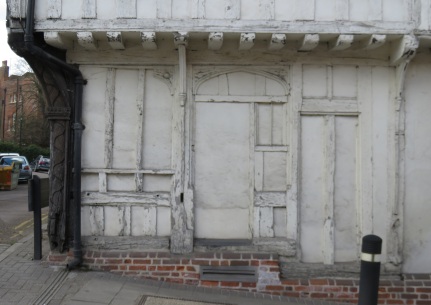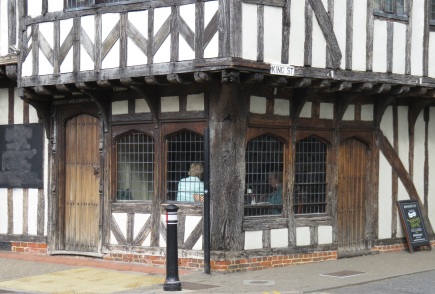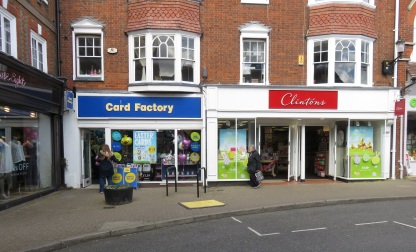
Market Hill
Not surprisingly, the Essex market town of Saffron Walden is rich in historic shopfronts. Here is a motley selection to enjoy!
No. 1 Myddleton Place
An unrestored example of a late medieval shop can be seen on the corner of Bridge Street, tucked under the jetty of 1 Myddleton Place. The timber frames of two arched windows with decoratively carved spandrels are still legible, although both have been subjected to a complicated sequence of alteration and blocking. To the right of the windows, the narrow shop doorway has also been infilled, but can be identified by its moulded surround.

Blocked medieval shopfront, 1 Myddleton Place (Bridge Street frontage).
Although this corner shop formed part of a substantial merchant’s house – perhaps built in the early 1500s by Thomas Myddleton, who was buried in the splendid parish church – it was probably let as a lock-up shop, with the shopkeeper selling goods through the open windows.

Restored medieval shopfront, Cross Keys Hotel.
Two similar, but restored, medieval shops can be seen closer to the town centre. One occupies the corner of the Cross Keys Hotel, at the junction of King Street and High Street. The other, now ‘The Corner Cupboard’ at 17 King Street, occupies the ground-floor cross-wing of a hall house dating from c.1500. Hints of other late medieval shops can be detected elsewhere in the town.

Restored medieval shopfront, 17 King Street.
Talents, 13 King Street
This is a well-proportioned late Georgian shopfront: double-fronted with flattened bow windows, narrow glazing bars, and a deep fascia. It might date from the 1820s or 30s.

Late Georgian shopfront, 13 King Street.
A photograph in the Historic England Archive, dated 1942, shows cigarette dispensers to either side of the shuttered right-hand window of the shop, which belonged to the tobacconist Simeon Aquilla Chilton. In the photograph, the name ‘Smith’ is faintly legible, though overpainted, on the fascia over the left-hand window. Census records (1881, 1891, 1901 and 1911) confirm that this was Eliza Smith’s hairdresser’s shop for many years. However, the identity of the occupant who put up this fine shopfront around 50 years earlier is not known.
Holland & Barrett (formerly John Emson’s), with Seasalt and Costa, 6 Market Square
The shop at 6 Market Square in Saffron Walden belonged, in the early 19th century, to the grocer and draper John Emson (1781-1849). Emson was ensconced here by 1810, when he advertised for a man of ‘unexceptional character’ to assist in the shop. The business occupied the entire north side of the Market Place, with a delivery entrance and wholesale department in a former malthouse to the right of the shop. A weighbridge installed in the street by Emson in 1812 was removed at the request of the Corporation in 1928 and has left no trace.

6 Market Square.
The shopfront was updated, probably in the 1840s, with the present classical detailing. The original small squares of glazing were replaced with large panes of plate glass (which were themselves replaced in the late 20th century).

6 Market Square
Emson served as mayor of Saffron Walden in 1834 and 1842, and the wrought-iron balcony with its tented canopy must have offered a perfect setting for delivering speeches. In 1832, the Whig politician Mr Western is known to have addressed the townspeople from Mr Emson’s balcony, over the shop windows.
After John Emson’s death, his sons John Green (1813-1900) and Frederick (1818-93) ran the business in partnership. John Green’s son, Frank Everitt Emson (1851-1933), was the author of Our Town, or Life at Slowborough (1886), based on local characters in Saffron Walden.
The shop passed through several hands in the 20th century: Emson, Tanner & Sons; Stebbing Leverett & Son (an established Saffron Walden draper); W. Eaden Lilley (a Cambridge department store), and Beales. After Beales closed, the shop – which had spread into the former warehouse – was subdivided into three separate retail units.
Hart & Son, printer & stationer, 18-20 King Street
Henry Hart (1801-83) set up in business in Saffron Walden in 1836 as a printer and stationer. His printing press has been preserved in Saffron Walden Museum.

Carriage arch next to 26 King Street.
By 1851 Hart had moved his shop from Market Street to 18 King Street. The carriage arch beside the present-day Hart’s Book Shop, at 26 King Street, gave access to the printing works to the rear of Hart’s shop, and still bears their signage.
No. 18 King Street is a listed building, thought to have been built in 1633. During alterations in 1870 workmen: ‘came upon an old “Witch Bottle,” embedded about 18 inches below the floor of the shop, and about 12 inches from the fireplace. It contained some water, about 40 horsenails, and 20 thorns. It is supposed to be 200 years old.’ A photograph of 1876 shows the large plate-glass shopfront – probably installed during the works of 1870 – occupying the entire width of the frontage. It is now divided between Clintons and Card Factory.

18-20 King Street.
The business was retained by the Hart family until 1934, when it was sold to Edwin Turnbull. Turnbull continued to trade under the Hart name, currently Hart Business Solutions.
Woolworth’s (now QD), 26-28 High Street
This branch of F. W. Woolworth & Co. Ltd. opened on Saffron Walden High Street on 29 June 1934, on the site of J. Wright’s garage. Woolworth’s had been building stores in medium-sized British towns for the previous 20 years, steadily colonising the country. The Saffron Walden branch was designated Store 548.

26-28 High Street in the 1980s. (c. Historic England Archive)
In deference to its setting in such an historic town, Store 548 was designed in a tasteful Georgian style, with two-tone brickwork and sash windows. It avoided the modish art deco detailing favoured at this time by Woolies’ architects.

26-28 High Street.
Today the building retains its original 1930s bronze shopfront, with neatly curved corners, of a type which was standardised across Woolworth’s estate between the wars. It has been painted bright red by the present occupant, QD. Like 1 Myddleton Place (above) it is that rare thing: an historic shopfront contemporary with the building which hosts it!

Pingback: Saffron Walden Woolworths – Store 548 | Woolies Buildings - Then and Now
Brilliant thrre is a lot more history of saffron walden in various books worth looking one by Jean grumball and one by mr stacy .
LikeLike
Brilliant there is a lot more history of saffron walden in various books worth looking one by Jean grumball and one by mr stacy .
LikeLike